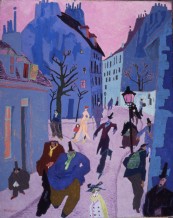The Colorful World of Lyonel Feininger
On a Wednesday afternoon, the elevator doors open and I step onto the third floor of the Whitney Museum of American Art. Museums on weekdays are a real treat. There is no need to navigate between throngs of people; there is just you and the art. The security guard greets me with a polite smile as I enter the exhibit. It is quiet and my heels hit the hardwood floor a bit too loud. Muted conversations reach my ears, some comprehensible, others in some foreign tongue. The cubic coffers above provide dim lighting, but they do not subdue the vibrancy of the paintings hanging before me. The yellow houses under a sky tinged green, whimsical figures walking down crooked streets with a childlike gaiety that can only reflect the iconic vision of German-American artist Lyonel Feininger.
Best known for his romantic depictions of architecture and seascapes, Feininger (1871-1956) is long recognized as a major figure of the Bauhaus (literally, “house of construction”). Curator Barbara Haskell describes his life as an “immigrant experience in reverse.” This is exactly what the Lyonel Feininger: At the Edge of the World exhibit presents.
Room after room, I feast my eyes on illustrations, paintings, photography, and even carvings from the different periods in Feininger’s life. Born in New York City, Feininger moved to Germany at the age of 16, where he attended classes at the Imperial Academy of Art. He eventually married, started a family, and became a successful comic illustrator and caricaturist.
Walking through the rooms, I see the progression of Feininger’s work. One of his earlier paintings, titled In a Village Near Paris, stood out to me the most. Figures appear to be hurrying down a village street at dusk in late autumn. Implausible colors and a variety of perspectives define the composition: buildings seem tilted and irregular, almost as if they are on the verge of toppling, and the scale is reordered—some of the human figures appear more substantial than the buildings. The distorted figures seen in the painting, with their strangely elongated small heads on large bodies or squat and rotund, recall Feininger’s Chicago Tribune comic series, The Kin-der-Kids and Wee Willie Winkie’s World, also on exhibit.
“[Feininger’s] early paintings emerged out of these comic strips,” says Haskell, “and he made these hand painted, hand carved toys as Christmas presents for his son that were also from these paintings.”
These toys grew into a vast collection that Feininger titled City at the End of the World. When I come upon the collection, I can’t help but to crouch down and observe the quirky faces and fanciful houses that are reminiscent of the subjects in his early paintings.
(Article continued on next page)

